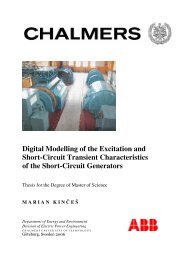Modeling and Simulation of Vehicular Power Systems - webfiles its ...
Modeling and Simulation of Vehicular Power Systems - webfiles its ...
Modeling and Simulation of Vehicular Power Systems - webfiles its ...
You also want an ePaper? Increase the reach of your titles
YUMPU automatically turns print PDFs into web optimized ePapers that Google loves.
4.1.1 Normal load on each wheel.The normal load on each rear <strong>and</strong> front axles for a passenger car depends on thedimension <strong>and</strong> shape <strong>of</strong> it. The normal load for a passenger car is found according to thefollowing equation [11].LhbgrddVWf= MvgCosα− ( Fgrade+ FAerodynamic+ MvgCrCosα+ Mv)LLhdtWr=LaLMvhggCosα− ( FLgrade+ FAerodynamic+ MvgCrrhdggCosα+ MvdVdt)( 4-13)Where h g is the height <strong>of</strong> vehicle center <strong>of</strong> gravity from the ground, L a <strong>and</strong> L b are thedistances <strong>of</strong> the front axle <strong>and</strong> the rear axle from the center <strong>of</strong> gravity respectively. L isthe total distance between front ant rear axles. The dimensions are shown in figure 4-1.As in passenger vehicles the center <strong>of</strong> application <strong>of</strong> aerodynamic force, h w <strong>and</strong> thegravity force are near the same height, h g , so the above equations are simplified toWWfr==LLbLaLMMvvhggCosα− ( FtLhggCosα− ( FtLrd− Fr(1 − ))hr− Fr(1 −hdgg))( 4-14)Where F t is the sum <strong>of</strong> front <strong>and</strong> rear tractive forces <strong>and</strong> F r is the sum <strong>of</strong> front <strong>and</strong> rearrolling resistance. r d is the effective radius <strong>of</strong> the wheel.4.1.2 Friction coefficient <strong>and</strong> slip modelingExperimental studies have produced several clearly defined friction/slip characteristicsbetween the tyre <strong>and</strong> road surface for a variety <strong>of</strong> different driving surfaces <strong>and</strong>conditions [12]. For the purposes <strong>of</strong> simulation, four types <strong>of</strong> road condition are modeled:• Normal: The road is dry <strong>and</strong> maximum traction is theoretically possible.• Wet/Raining: Overall traction is reduced by about 20 %.• Snow: Un-packed snow lies on the road surface. Maximum traction reduced by 65 %.• Ice: Packed frozen snow <strong>and</strong> black ice lie on the road surface. Highly dangerous –maximum traction reduced by 85 %.Graphically, these four conditions are shown in figure 4-5 below:20


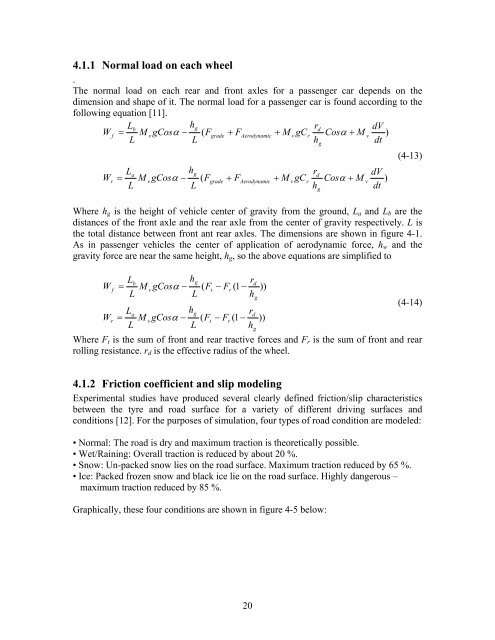
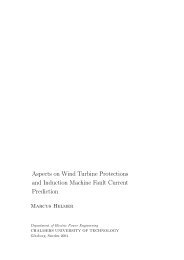
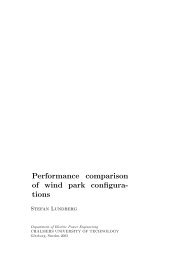
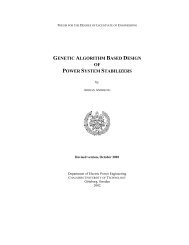

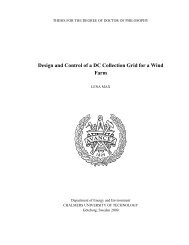

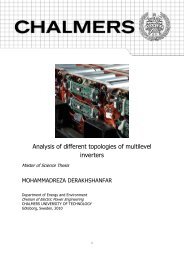

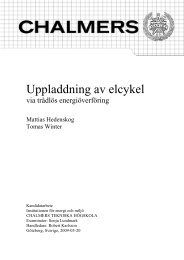
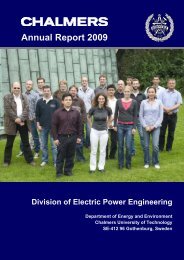
![LAPLACE OPERATOR.ppt [Lecture seule]](https://img.yumpu.com/42909900/1/190x135/laplace-operatorppt-lecture-seule.jpg?quality=85)

